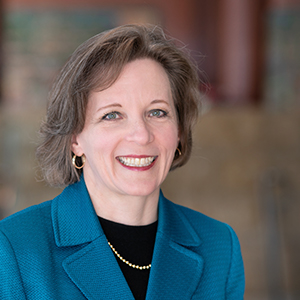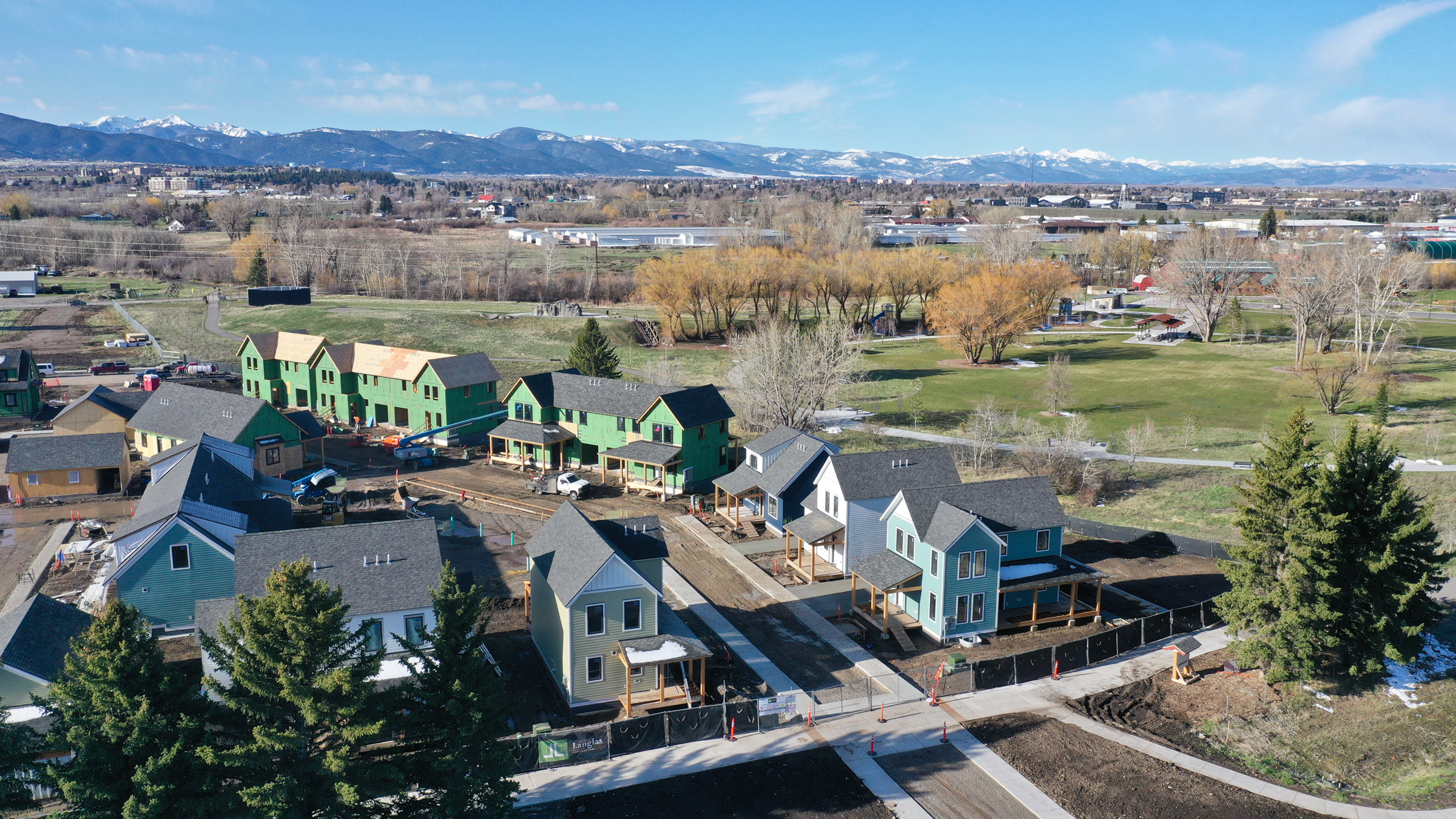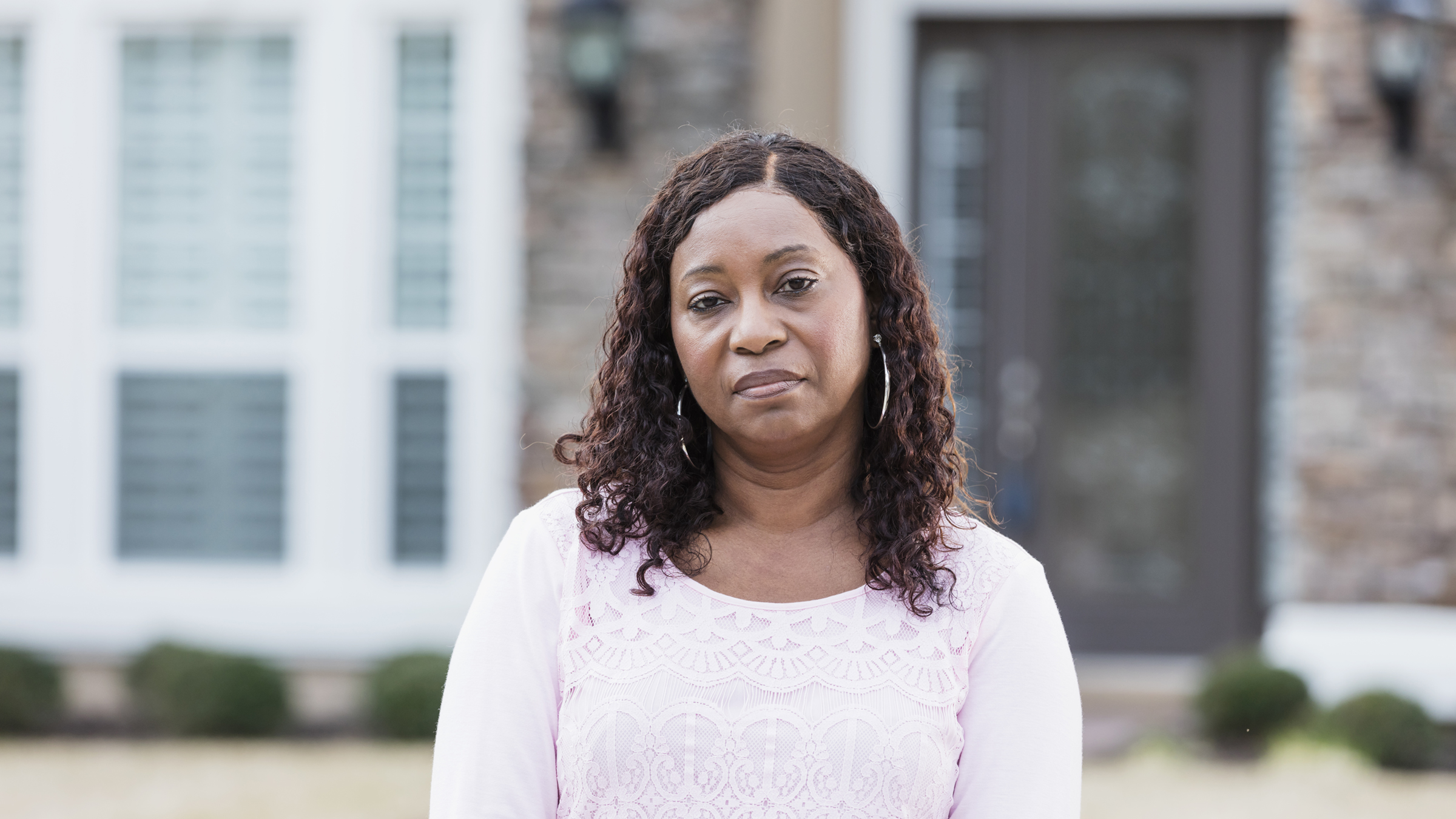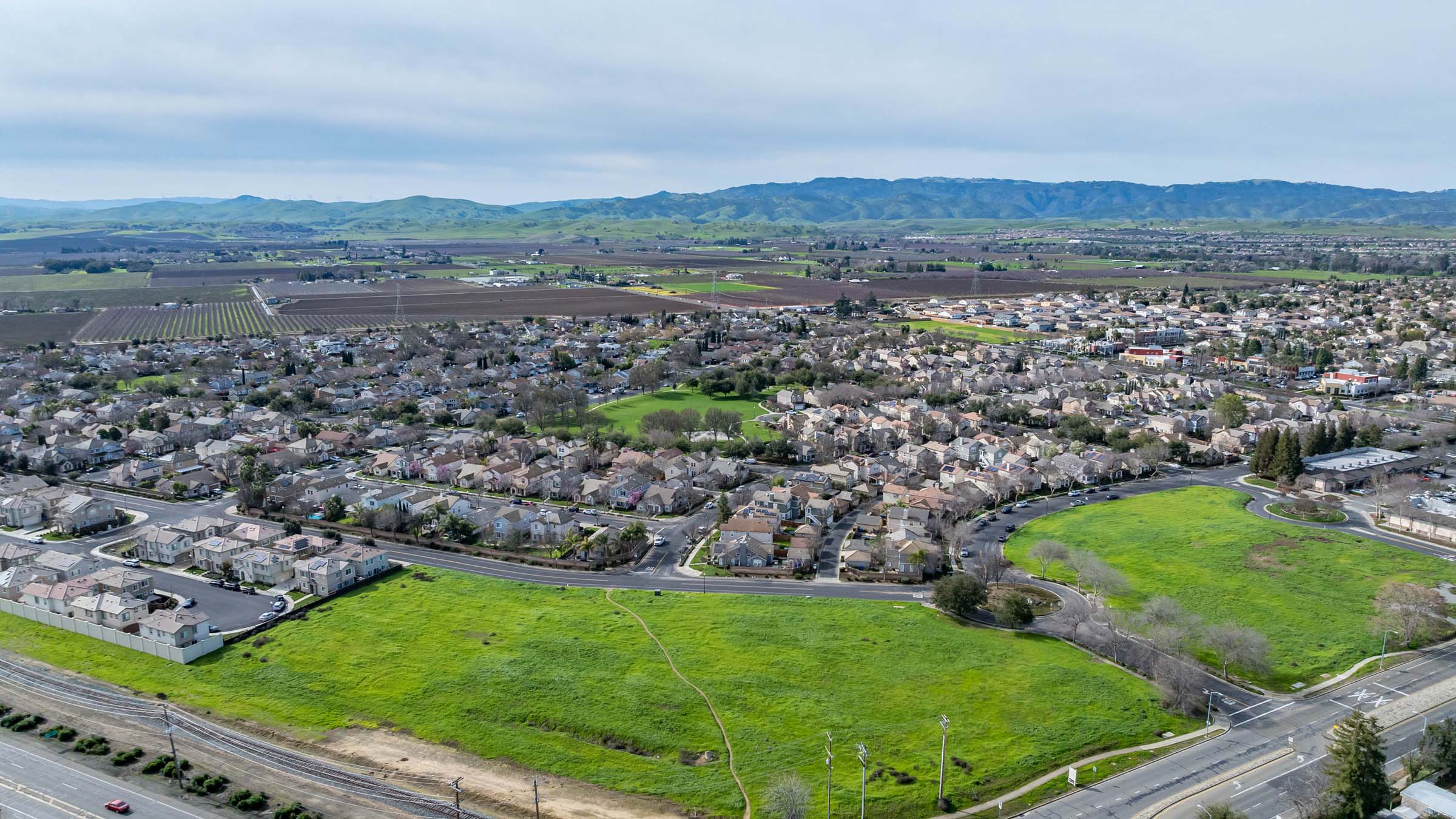Stand at the intersection of Bridger Drive and Story Mill Road in Bozeman, Montana, and your eyes will naturally gravitate to the picturesque Bridger Mountains ahead. Direct your gaze slightly downward and you will witness a neighborhood coming to life.
The Bridger View neighborhood aims to create a new way of living to accommodate Bozeman’s exploding population and respond to its rising home costs. When fully finished in the early summer of 2023, the eight-acre site will feature 62 homes—half of which will be sold at market rates and the other half at below-market prices for middle-income households. The lower sale prices are badly needed. Even with the below-market-rate loans and down-payment assistance that Montana Housing, the state’s housing finance agency, provides to low-, moderate-, and middle-income borrowers who might otherwise not be able to afford to purchase homes, prospective home buyers face a lack of affordable supply in the Bozeman market. According to a recent Bozeman Real Estate Group report, the median price of a single-family home in the city is $899,500.1
“We had four major goals: to meaningfully address housing affordability in this location, to build sustainably, to have a product that would be durable and stand the test of time, and to provide a model that’s feasible to build and replicable,” explained Christine Walker, a consultant for the Bridger View project and early planner.
The neighborhood’s below-market-rate homes are completely indistinguishable from the market-rate homes and located randomly throughout the neighborhood. Sixty-two homes on eight acres means smaller homes on smaller lots, something that stemmed from conversations with Bozeman residents.
“Instead of building high-rise apartments or developing single-family homes on quarter-acre parcels, people were looking for a mesh of those two. Something that was more walkable, a community,” said Walker.
That emphasis on community is clearly reflected in the neighborhood’s design, which features narrower-than-usual streets, three large common spaces, and pathways that connect to downtown Bozeman and the adjacent Story Mill Community Park, a 60-acre space that features more than three miles of trails, a dog park, an adventure playground, and a 40-acre nature sanctuary.
So far, Bridger View has received more than 1,000 requests for information on the below-market-price homes.
“There is such an urgent and growing need for houses that are priced in the ranges that we’re talking about. I receive probably 30 emails a day from people asking for information or clarification,” said Michael Brown, acting executive director of Headwaters Community Housing Trust (HCHT), the organization created to lead the project.
The double-edged sword of population growth
As some of its older residents will tell you, Bozeman hasn’t always been this populated. However, with the nearby Bridger Mountains, plenty of walking and hiking trails, premier cross-country and downhill skiing, and the fruitful fishing streams in Gallatin County and the surrounding area, it was only a matter of time.
“There’s an attractive quality of life here, so lots of people are interested in moving in—and not only people that make a lot of money and build fancy homes, but also just people who are interested in this lifestyle and want to take advantage of the surrounding resources,” said Brown, who speaks from experience, having visited Bozeman for the first time in 1970 to go skiing.
Indeed, people have moved in. Bozeman’s population hovered between 10,000 and 23,000 from 1950 to 1990, before increasing to about 28,000 in 2000. It jumped to about 37,000 in 2010, and by 2020 that number had expanded roughly 43 percent, for a population total of more than 53,000 people. Bozeman was ranked as the fastest-growing micropolitan area—that is, an area of between 10,000 and 50,000 people—in the United States in 2018, 2019, and 2020, before sizing out of the micropolitan category.
Brown describes Bozeman’s growth as a double-edged sword.
“With that growth comes real opportunity, but also comes challenges, and simple supply and demand puts a lot of pressure on the housing market. That’s been happening steadily over the last 30 to 40 years or more, and we saw a real spike in that during COVID when there were people interested in moving here and having that ability to work remotely,” he said.
At current interest rates and assuming a 10 percent down payment, buying the nearly $900,000, median-priced, single-family home in Bozeman requires an annual income of over $200,000. Compare this to the median family income in Gallatin County, Montana, of $91,484, and it’s easy to see how members of Bozeman’s workforce are getting priced out of purchasing houses.2
Planning and building Bridger View
As Bozeman’s population has undergone significant changes over recent decades, so has the Bridger View neighborhood site.
Originally Bridger Trailer Court, the area was once occupied by 92 families living in manufactured housing. In 2006, the families were forced out to make way for a 1,200-unit development that never got out of the planning phase. With the land sitting unoccupied and overgrown, the Trust for Public Land purchased the site in 2012 with a focus on creating a park that the entire community could use. However, the organization also had an additional plan: returning some affordable residential housing to the area.
By the time Story Mill Community Park officially opened in 2019, planning for the Bridger View neighborhood was well under way, although with some complexities.
“One of the key pieces that we directed our team to do, which was a little outside of the box, was to ignore the land-development regulations and engineering codes,” said Walker. “We wanted them to design a good neighborhood, instead of working within those code constraints. After we had a neighborhood design that we thought was functional, practical, and met our goals and objectives for the neighborhood, then we’d see where we were inconsistent with the development code.”
By the end of the planning process, the team had obtained 19 variances from the City of Bozeman to get approval for the new development. These variances included allowances for smaller and narrower lots, increased lot coverages, and decreased setbacks. Although it was tedious, obtaining the variances was necessary to ensure that Bridger View maximizes the site.
“We performed an exercise to see how many units of housing we could have built if we’d followed the code on more acreage than this. Following the development code, the team was able to put 35 units on 10 acres. And here we have 62 units on eight acres. What the planning process for Bridger View shows is just how the development code hampers building higher-density—and, quite frankly, more human-scale—development,” Walker says.
A number of local and national partnerships enabled the Bridger View neighborhood to accomplish one of its primary goals: to build sustainably and create sustainable housing. All 62 homes in the neighborhood are built to significantly higher energy-efficiency standards than the City of Bozeman requires. Bridger View was recently awarded Montana’s first U.S. Green Building Council LEED (Leadership in Energy and Environmental Design) Gold-level certification.
“What’s special about Bridger View is that it’s addressing a variety of different issues that we’re challenged with as a society. We’re addressing housing affordability, and with that we’re addressing income inequality. We’re addressing creating a healthy neighborhood. We’re reducing the vehicle miles traveled, so reducing emissions from cars for people who commute. We’re also creating homes that have much more healthy interiors, that are less energy-consumptive, and all of those pieces together are important to the success of the neighborhood and its residents,” said Walker.
Ensuring the affordable homes remain affordable
Because of an overwhelming interest in the below-market-rate homes, HCHT determined that the best way to select home buyers was through a weighted drawing, rewarding applicants who have lived in the Bozeman area for a certain number of years with more entries.
Buyers of the below-market-rate homes must be U.S. citizens, at least 19 years old, earn 75 percent or more of their household income locally, and own no other real estate. Applicants also must confirm that they have no more than $105,000 in assets and an income level below roughly 120 percent of area median income, depending on household size. (See the table for details.) Some home buyers may be able to access lending through Montana Housing, whose loans are available to smaller households earning up to $116,247 and three-or-more-person households earning up to $133,685.
| Household size | Maximum income |
|---|---|
| 1 | $88,000 |
| 2 | $101,000 |
| 3 | $113,000 |
| 4 | $126,000 |
| 5 | $136,000 |
| 6 | $146,000 |
| 7 | $156,000 |
| 8 | $166,000 |
The structure of HCHT enables homeowners to build equity while ensuring that their homes remain affordable. Each homeowner owns their home and leases the land the home sits on, a dual-ownership model that is standard for community land trusts. If a homeowner decides to move, they will be allowed to sell their home for the original price they paid plus compounding interest of 2.5 percent for each year they owned the home.
While the returns from the initial sales of the market-priced homes will offset some of the cost for selling the below-market-price homes at smaller values, some of the incurred cost will be covered by an anonymous donor through The Kendeda Fund, Bridger View’s philanthropic partner. Including land, site development, construction costs, soft costs (such as fees and permits), and contingencies, the total development cost for the Bridger View neighborhood is projected to be $44,500,000.
Keeping things in perspective
In many ways, Bridger View is one step in a long process to bring greater housing affordability to Bozeman. Reiterating the core values for the project, Christine Walker noted that the Bridger View neighborhood isn’t just about providing housing. There’s a broader goal as well: “As a society, we’re so divided right now, and part of it is that we just don’t interact with people who aren’t exactly like us. In some ways, we’re trying to bring back a traditional neighborhood where people of all different ages, stages of life, and incomes would interact in a community. I hope what we’re doing here is replicated,” she said.
As far as replication is concerned, Walker is doing her part. She is currently consulting on a project in Jackson Hole, Wyoming, that’s incorporating elements of the Bridger View neighborhood’s design into the build. Other cities around the country, including Portland, Oregon; Arlington, Virginia; and Seattle are changing codes or guidelines in an effort to promote building more middle-income housing.
Both Brown and Walker noted that ultimately, it’s important to keep things in perspective: “It’s been a complex process, but we’re going to have 31 elated and grateful homeowners here by this time next year, and those homes are going to remain affordable,” Brown said. “The homeowners will be able to build equity, but we’re going to keep the resale prices low enough to serve households in those same income ranges every time the ownership transfers from one household to the next. So, over the course of the useful life of those homes, hundreds will benefit.”
Endnotes
1 From the Bozeman Real Estate Blog’s “How Much Do Homes Currently Cost in Bozeman?” post as of August 2022.
2 American Community Survey 2016–2020 Five-Year Estimates from the U.S. Census Bureau.
Libby Starling is Senior Community Development Advisor in Community Development and Engagement at the Federal Reserve Bank of Minneapolis. She focuses on deepening the Bank’s understanding of housing affordability, concentrating on effective housing policies and practices that make a difference for low- and moderate-income families in the Ninth Federal Reserve District.







